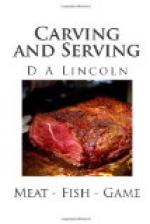HAUNCH OF VENISON OR MUTTON.
This is the leg and loin undivided, or, as more commonly called, the hind quarter.
The butcher should split the whirl-bone, disjoint the backbone, and split the ribs in the flank. The rump-bone and aitch-bone may be removed before cooking. Place it on the platter with the loin or backbone nearest the carver. Separate the leg from the loin; this is a difficult joint to divide when the bones have not been removed, but it can be done with practice. When the leg has been taken off, carve that as directed on page 19. Carve the loin by first cutting off the flank and dividing it, then divide between each rib in the loin, or cut long slices parallel with the backbone, in the same way as directed for a saddle of mutton. Some English authorities recommend cutting perpendicularly through the thickest part of the leg near the knuckle, and then cutting across at right angles with this first cut, in long thin slices, the entire length of the joint; the slices are then separated from the bone and divided as desired. When carved in this way the loin and leg are not divided. This is not so economical as the first method.
LOIN OF MUTTON, LAMB, VEAL, PORK, OR VENISON.
These should always be divided at the joints in the backbone by the butcher; then it is an easy matter to separate the ribs, serving one to each person, with a portion of the kidney and fat if desired. But if the butcher neglect to do this, and you have no cleaver with which to do it, it is better to cut slices down to the ribs parallel with the backbone, as directed in the saddle of mutton, than to suffer the annoyance of hacking at the joints.
Before cooking a loin of pork, gash through the fat between the ribs; this will give more of the crisp fat, and will aid in separating the ribs.
SHOULDER OF MUTTON OR VEAL.
Place it on the platter with the thickest part up. From the thickest part cut thin slices, slanting down to the knuckle; then make several cuts across to the larger end, and remove these slices from the shoulder-blade. Separate the blade at the shoulder-joint, and remove it. Cut the meat under the blade in perpendicular slices.
Any part of the forequarter of mutton is more tender and palatable, and more easily carved, if before cooking it be boned and stuffed. Or it may be boned, rolled, and corned.




